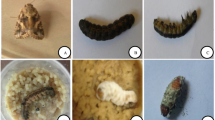Abstract
Conidia of the soybean anthracnose fungus, Colletotrichum truncatum differentiate to form appressoria required for host invasion when the germ tube touches a hard surface. This thigmotrophic stimulus appears to be translated by the fungus during the second round of nuclear division. Inhibiting the second round of DNA synthesis by fluorodeoxyuridine or hydroxyurea blocked appearance of appressoria but not emergence of the germ tube. DNA synthesis and mitosis resumed upon removal of FUdR but only mycelia formed, and infection structures did not appear. In addition, actinomycin D reversibly blocked development of appressoria and synthesis of polyadenylate, but nuclear division was not affected. The data suggest that anthracnose conidia produce appressoria in response to germ tube contact by altering the messenger program of its germ tube nucleus. This study has also shown that mitochondrial DNA had an unusual bimodal distribution in CsCl at 1.690 and 1.719 g/cm3, respectively.
Similar content being viewed by others
Abbreviations
- FUdR:
-
5-fluorodeoxyuridine
- polyA:
-
polyadenylic acid
References
Allen, R. F.: A cytological study of Puccinia triticina physiologic form II on Little Club Wheat. J. Agric. Res. 33, 201–222 (1926
Bessey, E. A.: Morphology and taxonomy of fungi. Philadelphia: Blakiston 1952
Borst, P.: Mitochondrial nucleic acids. Ann. Rev. Biochem. 41, 333–376 (1972)
Burger, M. M.: S8rface changes in transformed cells detected by lectins. Fed. Proc. 32, 91–101 (1973)
Chakravarti, B. P.: Attempts to alter infection processes and aggressiveness of Puccinia graminis var. tritici. Phytopathology 56, 223–229 (1966)
Colotelo, N., Grinchenko, A. H. H.: Growth of Kabatiella caulivora on different media. Canad. J. Bot. 40, 439–446 (1962)
Dey, P. K.: Studies in the physiology of parasitism. V. Infection by Colletotrichum lindemuthianum. Ann. Bot. 33, 305–312 (1919)
Dickinson, S.: Studies in the physiology of obligate parasitism. VIII. An analysis of fungal responses to thigmotropic stimuli. Phytopath. Z. 70, 62–70 (1971)
Edmonds, M., Caramela, G.: The isolation and characterization of adenosine monophosphate-rich polynucleotides synthesized by Ehrlichascites cells. J. biol. Chem. 244, 1314–1324 (1969)
Finney, D. J.: Probit analysis, 2nd ed. Cambridge: Cambridge University Press 1952
Giles, K. W., Myers, A.: An improved diphenylamine method for the estimation of deoxyribonucleic acid. Nature (Lond.) 206, 93 (1965)
Greenberg, J. R., Perry, R. P.: The isolation and characterization of steady-state labeled messenger RNA from L-cells. Biochim. biophys. Acta (Amst.) 287, 361–366 (1972)
Gurdon, J. B., Woodland, H. R.: The cytoplasmic control of nuclear activity in animal development. Biol. Rev. 43, 233–267 (1968)
Kupila, S., Bryan, A. M., Stern, H.: Extractability of DNA and its determination in tissues of higher plants. Plant Physiol. 36, 212–215 (1961)
Lewin, B. M.: Gene expression, Vol. 2. New York: Wiley 1974
Luck, D. J. L., Reich, E.: DNA in mitochondria of Neurospora crassa. Proc. nat. Acad. Sci. (Wash.) 52, 931–938 (1964)
Maheshwari, R., Allen, P. J., Hildebrandt, A. C.: Physical and chemical factors controlling the development of infection structures from urediospore germ tubes of rust fungi. Phytopathology 57, 855–862 (1967)
Manahan, C. O., App, A. A., Still, C. C.: The presence of polyadenylate sequences in the ribonucleic acid of a higher plant. Biochem. biophys. Res. Commun. 53, 588–595 (1973)
Mercer, P. C., Wood, R. K. S., Greenwood, A. D.: Ultrastructure of the parasitism of Phaseolus vulgaris by Colletotrichum lindemuthianum. Physiol. Plant Path. 5, 203–214 (1975)
Miehle, B. R., Lukezic, F. L.: Studies on conidial germination and appressorium formation by Colletotrichum trifolii Bain & Essary. Canad. J. Microbiol. 18, 1263–1269 (1972)
Parsons, P., Simpson, M. V.: Deoxyribonucleic acid biosynthesis in mitochondria. Studies on the incorporation of labeled precursors into mitochondrial deoxyribonucleic acid. J. biol. Chem. 248, 1912–1919 (1973)
Politis, D. J., Wheeler, H.: Ultrastructural study of penetration of maize leaves by Colletotrichum graminicola. Physiol. Plant Path. 3, 465–471 (1973)
Preece, T. F., Barnes, G., Bayley, J. M.: Junctions between epidermal cells as sites of appressorium formation by plant pathogenic fungi. Plant Path. 16, 117–118 (1967)
Roth, R., Ashworth, J. M., Sussman, M.: Periods of genetic transcription required for the synthesis of three enzymes during cellular slime mold development. Proc. nat. Acad. Sci. (Wash.) 59, 1235–1242 (1968)
Sampson, K.: Comparative studies of Kabatiella caulivora (Kerchn.) Kana, and Colletotrichum trifolii Bain and Essary, two fungi which cause red clover anthracnose. Trans. Brit. Mycol. Soc. 13, 103–142 (1929)
Schildkraut, C. L., Marmur, J., Doty, P.: Determination of the base composition of deoxyribonucleic acid from its buoyant density in CsCl. J. molec. Biol. 4, 430–443 (1962)
Staples, R. C.: Synthesis of DNA during differentiation of bean rust uredospores. Physiol. Plant Path. 4, 415–424 (1974)
Staples, R. C., App, A. A., Ricci, P.: DNA synthesis and nuclear division during formation of infection structures by bean rust uredospore germlings. Arch. Microbiol. 104, 123–127 (1975)
Williams, P. G., Ledingham, G. A.: Preparation and properties of a mitochondrial fraction from wheat stem rust uredospores. Canad. J. Bot. 42, 497–505 (1964)
Wynn, W. K.: Appressorium formation over stomates by the bean rust fungus: response to a surface contact stimulus. Phytopathology 66, 136–146 (1976)
Wynn, W. K., Gajdusek, C.: Metabolism of glucomannan-protein during germination of bean rust spores. Contr. Boyce Thompson Inst. 24, 123–138 (1968)
Yang, S. L., Ellingboe, A. H.: Cuticle layer as a determining factor for the formation of mature appressoria of Erysiphe graminis on wheat and barley. Physopathology 62, 708–714 (1972)
Author information
Authors and Affiliations
Rights and permissions
About this article
Cite this article
Staples, R.C., Laccetti, L. & Yaniv, Z. Appressorium formation and nuclear division in Colletotrichum truncatum . Arch. Microbiol. 109, 75–84 (1976). https://doi.org/10.1007/BF00425115
Received:
Issue Date:
DOI: https://doi.org/10.1007/BF00425115




